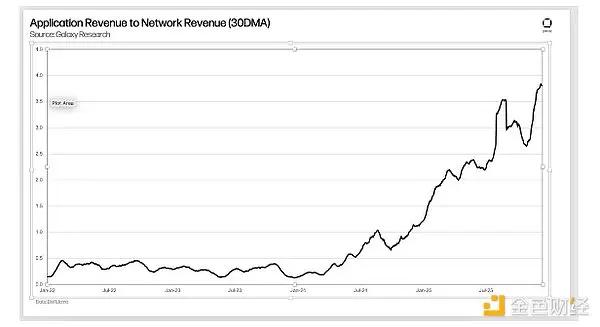
The inspiration for this article comes from a series of conversations with Ganesh Swami, covering topics such as the seasonality of revenue, the evolution of business models, and whether token buybacks are the best use of protocol capital. This is a supplement to my previous article on the stagnation of cryptocurrencies.
Private capital markets like venture capital oscillate between excess liquidity and scarcity. When these assets become liquid and external capital floods in, market frenzy drives up prices. Think of newly launched IPOs or token offerings. The newfound liquidity allows investors to take on more risk, which in turn spawns a new generation of companies. As asset prices rise, investors seek to shift capital to early applications, hoping to achieve higher returns than benchmarks like ETH and SOL. This is a feature, not a bug.

The liquidity of cryptocurrencies follows the cyclical pattern of Bitcoin's halving. Historically, market rallies have occurred within six months of a Bitcoin halving. In 2024, ETF inflows and Saylor's purchases will become Bitcoin's supply absorbers. Saylor alone spent $22.1 billion on Bitcoin last year. However, the price surge of Bitcoin last year did not translate into a rebound in the long tail of small Altcoins.
We are witnessing an era where capital allocators are liquidity-constrained, with attention scattered across thousands of assets, while founders who have toiled on tokens for years struggle to find meaning in it. Why would anyone bother building real applications when Meme assets can generate more financial returns? In previous cycles, L2 tokens enjoyed a premium due to the listing of trading platforms and venture capital support, driven by perceived value. But as more participants enter the market, this perception (and its valuation premium) is disappearing.
As a result, the token valuations of L2s have declined, limiting their ability to subsidize smaller products through grants or token-based revenue. This overvaluation, in turn, forces founders to confront an age-old question that plagues all economic activity - where does the revenue come from?
So Transactional

The image above nicely illustrates the typical workings of cryptocurrency revenue. For most products, the ideal state is that of AAVE and Uniswap. Attributable to the Lindy effect or early mover advantage, these two products have maintained fees for years. Uniswap can even increase front-end fees and generate revenue. This speaks to the degree of consumer preference definition. Uniswap to decentralized trading platforms is like Google to search.
In contrast, friendtech and OpenSea's revenues have seasonality. The NFT summer market cycle lasted two quarters, while social finance speculation lasted only two months. If the scale of revenue is large enough and consistent with product intent, speculative revenue makes sense. Many Meme trading platforms have joined the $100 million+ fee club. This scale is what most founders could hope for at best through tokens or acquisitions. But for most founders, such success is rare. They are not building consumer applications; they are focused on infrastructure, where revenue dynamics are different.
Between 2018 and 2021, VCs heavily funded developer tools, hoping developers would attract large user bases. But by 2024, two major shifts have occurred in the ecosystem. First, smart contracts have enabled limitless scaling with minimal human intervention. Uniswap or OpenSea don't need to scale their teams proportionally to transaction volume. Second, advancements in LLMs and AI have reduced the investment demand for cryptocurrency developer tools. As a category, it is now in a state of liquidation.
In Web2, the API-based subscription model worked because of the massive online user base. However, Web3 is a smaller niche market, with few applications scaling to millions of users. Our advantage is the high revenue metrics per user. Cryptocurrency users tend to spend more money more frequently, as blockchains enable this - they make money flow possible. Therefore, over the next 18 months, most businesses will have to redesign their business models to directly extract revenue from users in the form of transaction fees.

This is not a new concept. Stripe initially charged per API call, Shopify charged a fixed subscription fee, and both later shifted to revenue-share models. For infrastructure providers, this transition is quite direct in Web3. They will compete on API pricing to eat into the market - they may even offer the product for free up to a certain transaction volume, then negotiate revenue sharing. This is the ideal hypothetical scenario.
What would this look like in practice? One example is Polymarket. Currently, the UMA protocol's tokens are used for dispute resolution, with the tokens tied to the disputes. The more markets, the higher the probability of disputes occurring. This drives demand for UMA tokens. In the trading model, the required margin can be a small fraction of the total bet, say 0.10%. For example, a $1 billion bet on the outcome of a presidential election would generate $1 million in revenue for UMA. In the hypothetical scenario, UMA could use this revenue to buy back and burn their tokens. This approach has its benefits and challenges, which we will soon see.
Another participant doing this is MetaMask. The transaction volume processed through its embedded exchange feature is around $36 billion. The exchange revenue alone is over $300 million. A similar model applies to staking providers like Luganode, where fees are based on the amount of staked assets.
But in a market where API call costs are increasingly declining, why would developers choose one infrastructure provider over another? If revenue sharing is required, why choose one oracle over another? The answer lies in network effects. Data providers that support multiple blockchains, provide unparalleled data granularity, and can index new chains faster will become the preferred choice for new products. The same logic applies to intent or Gas-less exchange drivers. The more chains supported, the lower the profit margins, the faster the speed, the more likely to attract new products, as this marginal efficiency helps retain users.
Burn It All
The shift of tying token value to protocol revenue is not new. In recent weeks, several teams have announced mechanisms to buy back or burn tokens proportional to revenue. Notable among them are SkyEcosystem, Ronin Network, Jito SOL, Kaito AI, and Gearbox Protocol. Token buybacks are similar to stock buybacks in the US stock market - essentially a way to return value to shareholders (or in this case, token holders) without violating securities laws. In 2024, the US market alone had around $790 billion in stock buybacks, up from $170 billion in 2000. Whether these trends will continue remains to be seen, but we see a clear bifurcation in the market, with tokens that have cash flow and are willing to invest in their own value on one side, and those that have neither on the other.

For most early protocols or dApps, using revenue to buy back their own tokens may not be the best use of capital. One way to execute such operations is to allocate sufficient capital to offset the dilution from new token issuances. This is how the Kaito founders recently explained their token buyback approach. Kaito is a centralized company that uses tokens to incentivize its user base. The company generates centralized cash flow from its enterprise clients. They use a portion of this cash flow to execute buybacks through market makers. The purchased amount is double the new issuance, effectively making the network deflationary.
Ronin, on the other hand, has adopted a different approach. The blockchain adjusts fees based on the number of transactions in each block. During periods of high usage, a portion of the network fees will be deposited into Ronin's treasury. This is a way to control the asset supply without necessarily repurchasing the tokens themselves. In both cases, the founders have designed mechanisms to link value to network economic activity.
In future articles, we will delve deeper into how these operations impact the pricing and on-chain behavior of the tokens involved in such activities. But for now, it is evident that - with valuations being suppressed and the amount of venture capital flowing into cryptocurrencies decreasing - more teams will have to compete for the marginal funds entering our ecosystem. Since blockchains are essentially capital tracks, most teams will shift towards a model where fees are charged proportional to transaction volume. When this happens, if the teams are tokenized, they will have an incentive to issue buyback and burn models. The teams that do this well will become winners in the liquidity markets.
Of course, one day, all this talk about pricing, yields, and revenues will become irrelevant. We will once again spend money on dog pictures and buy monkey NFTs. But if I look at the current state of the market, most founders concerned about survival have already started discussions around revenues and burning.
Welcome to join the official BlockBeats community:
Telegram Subscription Group: https://t.me/theblockbeats
Telegram Discussion Group: https://t.me/BlockBeats_App
Twitter Official Account: https://twitter.com/BlockBeatsAsia







